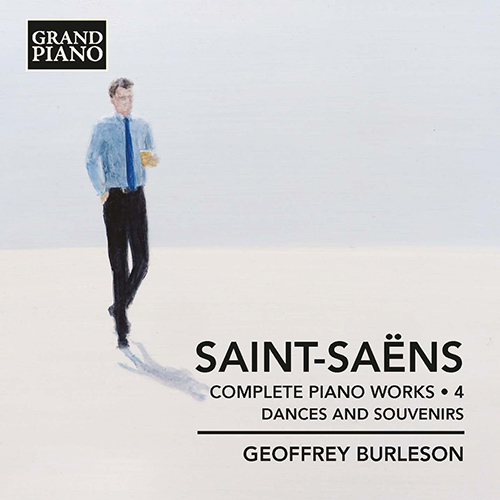
About this Release
“Like Chopin, Saint-Saëns wrote a substantial body of 'concert dance pieces' that I find completely captivating, full of wit, enchantment and musical ingenuity. For me, his 3 Mazurkas are the equal of Chopin’s brilliant works in this genre. His 'character waltzes', as I call them, are simultaneously 'concert waltzes' and character pieces; an original genre that I find consistently compelling and enthrallingly inventive. They also regularly go down unexpected avenues, such as the beautifully ethereal middle section of the Valse nonchalante, which are the greatest pleasure to play. Saint-Saëns' 'Souvenirs' are vivid musical travelogues of Italy and Egypt, and quite virtuosic. It has been enormously rewarding for me to perform and record such evocative tone poems.” — Geoffrey Burleson
SAINT-SAËNS, CAMILLE (1835–1921)
Complete Piano Works • 4
Dances and Souvenirs
- Geoffrey Burleson, piano
Although he is best remembered for his orchestral and instrumental music, Saint-Saëns was also responsible for spearheading the revival of the French Baroque, especially the music of Lully and Rameau, as well as being perfectly placed to absorb the latest instrumental dance music. His five ‘character waltzes’ include the ethereal and ravishingly textured Valse mignonne, the stylistically forward-looking Valse nonchalante and the virtuosic Valse gaie, the composer’s final waltz for solo piano, while the three minor key Mazurkas are strongly characterised and filled with ingenious musical contrasts. Last but not least, the three ‘souvenirs’ are delightful evocations of particular corners of the world that inspired Saint-Saëns.
Tracklist
|
1
Gavotte in C Minor, Op. 23 (1871) (00:03:05)
|
|
2
Mazurka No. 1 in G Minor, Op. 21 (1862) (00:03:32)
|
|
3
Mazurka No. 2 in G Minor, Op. 24 (1871) (00:04:19)
|
|
4
Mazurka No. 3 in B Minor, Op. 66 (1882) (00:05:19)
|
|
5
Menuet et valse, Op. 56 (1872) (00:12:27)
|
|
6
Valse canariote in A Minor, Op. 88 (1890) (00:05:28)
|
|
7
Valse mignonne in E-Flat Major, Op. 104 (1896) (00:03:13)
|
|
8
Valse nonchalante in D-Flat Major, Op. 110 (1899) (00:04:00)
|
|
9
Valse langoureuse in E Major, Op. 120 (1903) (00:04:36)
|
|
10
Valse gaie, Op. 139 (1912) (00:05:27)
|
|
11
Une nuit à Lisbonne in E-Flat Major, Op. 63 (1880) (00:04:39)
|
|
12
Souvenir d'Italie in G Major, Op. 80 (1887) (00:08:55)
|
|
13
Souvenir d'Ismailia, Op. 100 (1895) (00:06:52)
|
The Artist(s)
 Geoffrey Burleson has performed to wide acclaim throughout Europe and North America, and is equally active as a recitalist, concerto soloist, chamber musician and jazz performer. His numerous acclaimed solo appearances include performances at prestigious venues. He has also appeared as featured soloist at the Mostly Modern, Bard Music, Monadnock, Mänttä and Santander Music Festivals, the Talloires International Festival in France and the International Keyboard Institute & Festival in New York.
Geoffrey Burleson has performed to wide acclaim throughout Europe and North America, and is equally active as a recitalist, concerto soloist, chamber musician and jazz performer. His numerous acclaimed solo appearances include performances at prestigious venues. He has also appeared as featured soloist at the Mostly Modern, Bard Music, Monadnock, Mänttä and Santander Music Festivals, the Talloires International Festival in France and the International Keyboard Institute & Festival in New York. The Composer(s)
 Once described as the French Mendelssohn, Camille Saint-Saëns was talented and precocious as a child, with interests by no means confined to music. He made an early impression as a pianist. Following established French tradition, he was for nearly 20 years organist at the Madeleine in Paris and taught briefly at the École Niedermeyer, where he befriended his pupil Gabriel Fauré. He was a co-founder of the important Société Nationale de Musique with the patriotic aim of promoting contemporary French music in the aftermath of the Franco-Prussian war of 1870-01, in which he had served in the Garde Nationale de la Seine. Prolific and versatile as a composer, he contributed to most genres of music, but by the time of his death in 1921 his popularity in France had diminished considerably, as fashions in music had changed.
Once described as the French Mendelssohn, Camille Saint-Saëns was talented and precocious as a child, with interests by no means confined to music. He made an early impression as a pianist. Following established French tradition, he was for nearly 20 years organist at the Madeleine in Paris and taught briefly at the École Niedermeyer, where he befriended his pupil Gabriel Fauré. He was a co-founder of the important Société Nationale de Musique with the patriotic aim of promoting contemporary French music in the aftermath of the Franco-Prussian war of 1870-01, in which he had served in the Garde Nationale de la Seine. Prolific and versatile as a composer, he contributed to most genres of music, but by the time of his death in 1921 his popularity in France had diminished considerably, as fashions in music had changed. Reviews
“Burleson has immersed himself in the entirety of Saint-Saëns output and is a powerful advocate for this music.” – American Record Guide
“Burleson’s performances are able and musicianly…” – Gramophone
“Overall, this is a superb disc played by a very talented pianist who is more than able to cope with the Saint-Saëns’ myriad technical details and colours.” – MusicWeb International
“…Burleson does a wonderful job of honoring the “dance roots” of these selections. …[He] plays as if he believes that there is more substance to what he is playing; and the attentive listener is likely to agree with him.” – Examiner.com
“The American pianist, Geoffrey Burleson, ideally mixes the passages of seductive beauty with those that are very busy, his playing always well detailed.” – David’s Review Corner

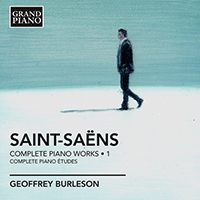
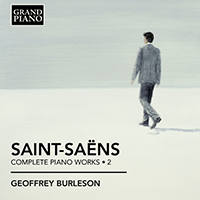
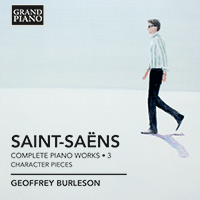
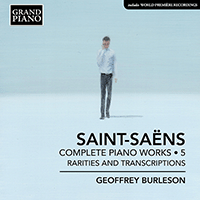
 Grand Piano has gained a reputation for producing high quality recordings of rare keyboard gems. Dedicated to the exploration of undiscovered piano repertoire, the label specialises in complete cycles of piano works by many lesser-known composers, whose output might otherwise have remained unknown and unrecorded.
Grand Piano has gained a reputation for producing high quality recordings of rare keyboard gems. Dedicated to the exploration of undiscovered piano repertoire, the label specialises in complete cycles of piano works by many lesser-known composers, whose output might otherwise have remained unknown and unrecorded.






